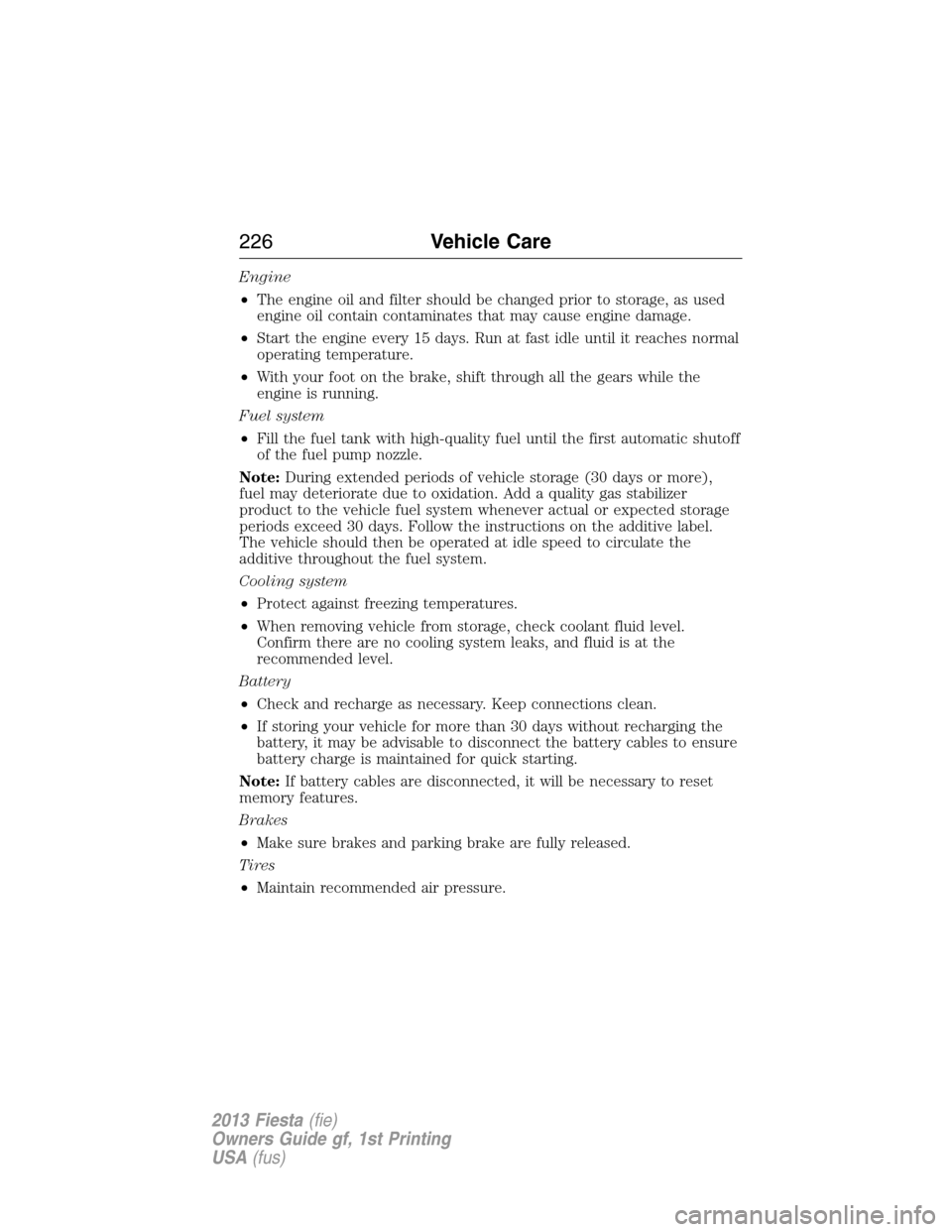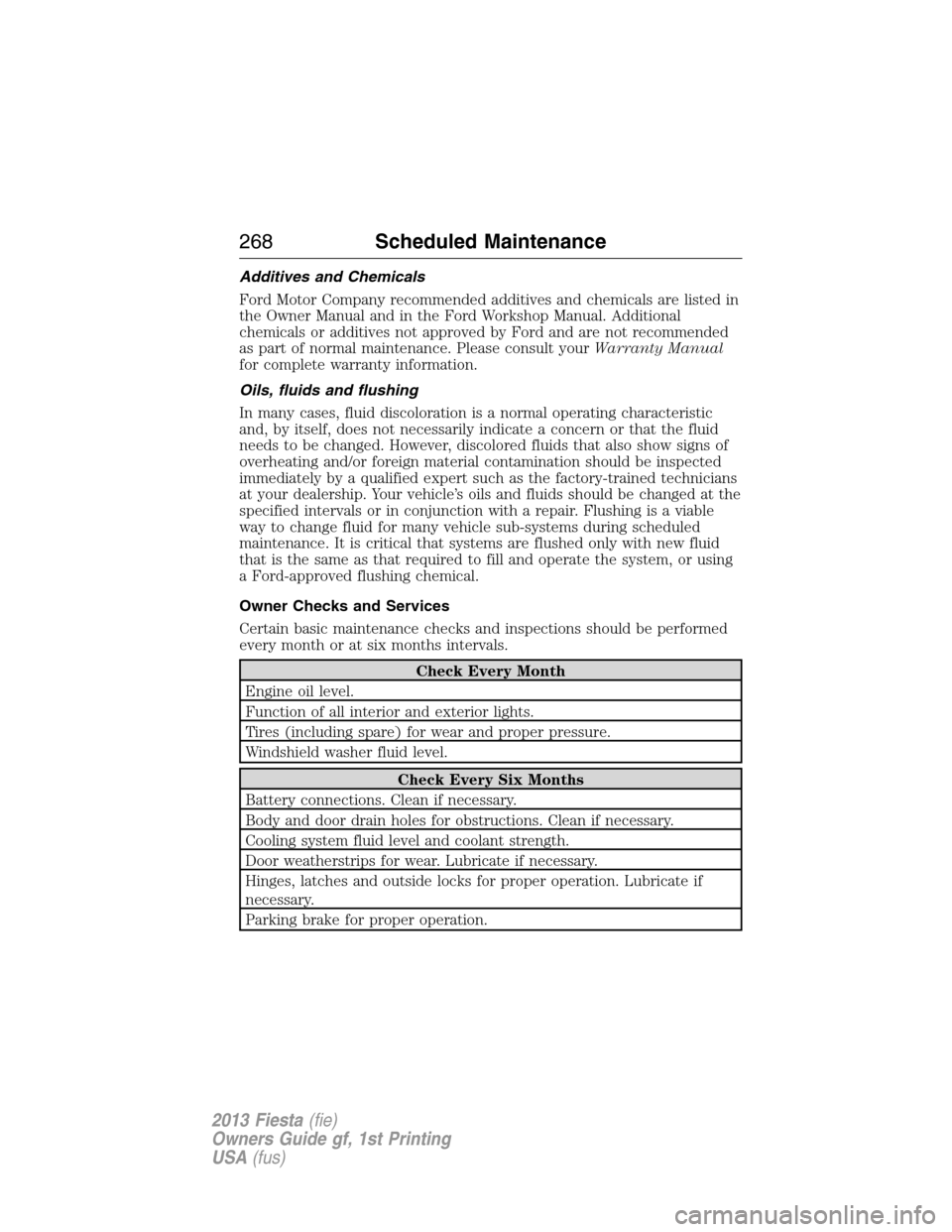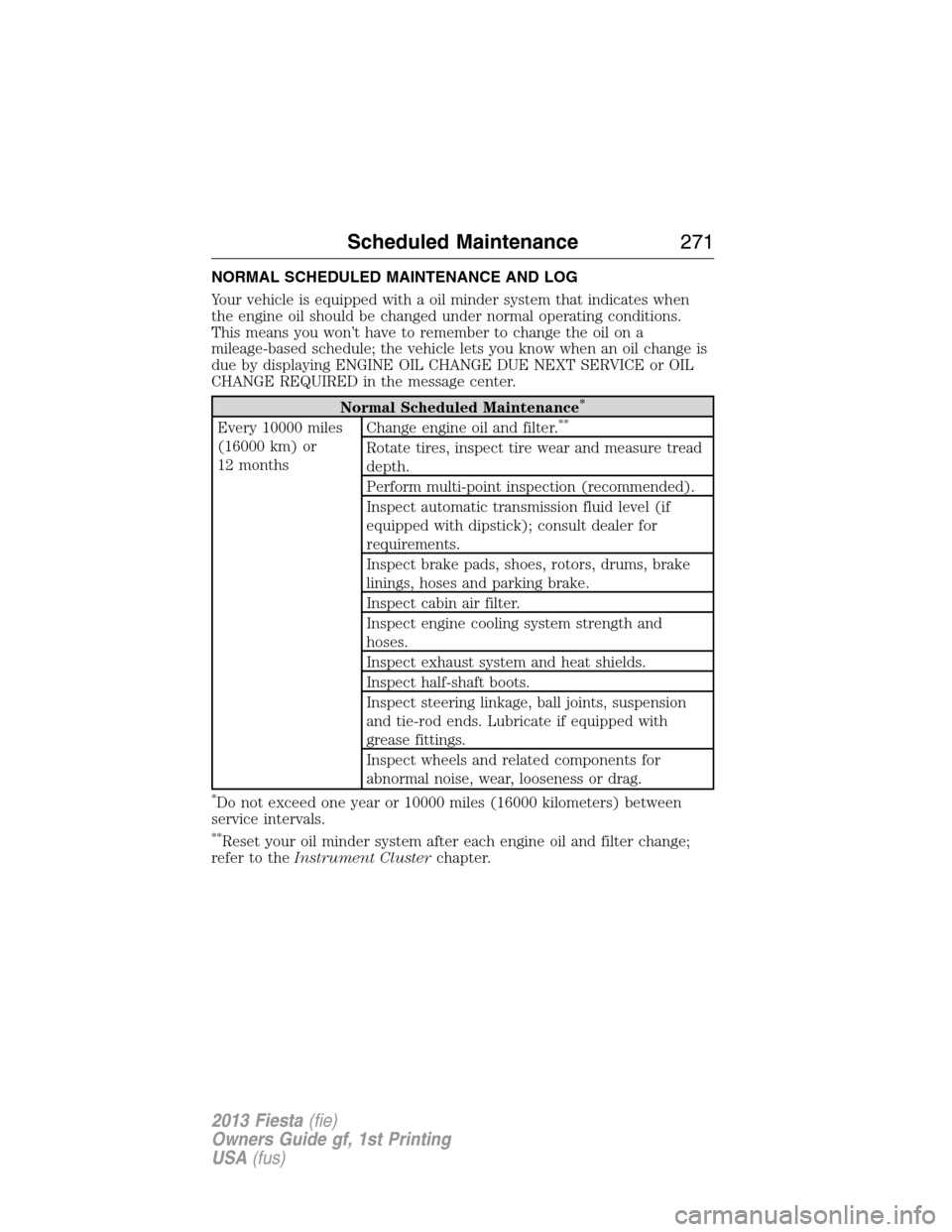Page 226 of 341

Engine
•The engine oil and filter should be changed prior to storage, as used
engine oil contain contaminates that may cause engine damage.
•Start the engine every 15 days. Run at fast idle until it reaches normal
operating temperature.
•With your foot on the brake, shift through all the gears while the
engine is running.
Fuel system
•Fill the fuel tank with high-quality fuel until the first automatic shutoff
of the fuel pump nozzle.
Note:During extended periods of vehicle storage (30 days or more),
fuel may deteriorate due to oxidation. Add a quality gas stabilizer
product to the vehicle fuel system whenever actual or expected storage
periods exceed 30 days. Follow the instructions on the additive label.
The vehicle should then be operated at idle speed to circulate the
additive throughout the fuel system.
Cooling system
•Protect against freezing temperatures.
•When removing vehicle from storage, check coolant fluid level.
Confirm there are no cooling system leaks, and fluid is at the
recommended level.
Battery
•Check and recharge as necessary. Keep connections clean.
•If storing your vehicle for more than 30 days without recharging the
battery, it may be advisable to disconnect the battery cables to ensure
battery charge is maintained for quick starting.
Note:If battery cables are disconnected, it will be necessary to reset
memory features.
Brakes
•Make sure brakes and parking brake are fully released.
Tires
•Maintain recommended air pressure.
226Vehicle Care
2013 Fiesta(fie)
Owners Guide gf, 1st Printing
USA(fus)
Page 268 of 341

Additives and Chemicals
Ford Motor Company recommended additives and chemicals are listed in
the Owner Manual and in the Ford Workshop Manual. Additional
chemicals or additives not approved by Ford and are not recommended
as part of normal maintenance. Please consult yourWarranty Manual
for complete warranty information.
Oils, fluids and flushing
In many cases, fluid discoloration is a normal operating characteristic
and, by itself, does not necessarily indicate a concern or that the fluid
needs to be changed. However, discolored fluids that also show signs of
overheating and/or foreign material contamination should be inspected
immediately by a qualified expert such as the factory-trained technicians
at your dealership. Your vehicle’s oils and fluids should be changed at the
specified intervals or in conjunction with a repair. Flushing is a viable
way to change fluid for many vehicle sub-systems during scheduled
maintenance. It is critical that systems are flushed only with new fluid
that is the same as that required to fill and operate the system, or using
a Ford-approved flushing chemical.
Owner Checks and Services
Certain basic maintenance checks and inspections should be performed
every month or at six months intervals.
Check Every Month
Engine oil level.
Function of all interior and exterior lights.
Tires (including spare) for wear and proper pressure.
Windshield washer fluid level.
Check Every Six Months
Battery connections. Clean if necessary.
Body and door drain holes for obstructions. Clean if necessary.
Cooling system fluid level and coolant strength.
Door weatherstrips for wear. Lubricate if necessary.
Hinges, latches and outside locks for proper operation. Lubricate if
necessary.
Parking brake for proper operation.
268Scheduled Maintenance
2013 Fiesta(fie)
Owners Guide gf, 1st Printing
USA(fus)
Page 271 of 341

NORMAL SCHEDULED MAINTENANCE AND LOG
Your vehicle is equipped with a oil minder system that indicates when
the engine oil should be changed under normal operating conditions.
This means you won’t have to remember to change the oil on a
mileage-based schedule; the vehicle lets you know when an oil change is
due by displaying ENGINE OIL CHANGE DUE NEXT SERVICE or OIL
CHANGE REQUIRED in the message center.
Normal Scheduled Maintenance*
Every 10000 miles
(16000 km) or
12 monthsChange engine oil and filter.**
Rotate tires, inspect tire wear and measure tread
depth.
Perform multi-point inspection (recommended).
Inspect automatic transmission fluid level (if
equipped with dipstick); consult dealer for
requirements.
Inspect brake pads, shoes, rotors, drums, brake
linings, hoses and parking brake.
Inspect cabin air filter.
Inspect engine cooling system strength and
hoses.
Inspect exhaust system and heat shields.
Inspect half-shaft boots.
Inspect steering linkage, ball joints, suspension
and tie-rod ends. Lubricate if equipped with
grease fittings.
Inspect wheels and related components for
abnormal noise, wear, looseness or drag.
*Do not exceed one year or 10000 miles (16000 kilometers) between
service intervals.
**Reset your oil minder system after each engine oil and filter change;
refer to theInstrument Clusterchapter.
Scheduled Maintenance271
2013 Fiesta(fie)
Owners Guide gf, 1st Printing
USA(fus)
Page 338 of 341

Engine fan .................................198
Engine oil
dipstick ....................................199
filter, specifications ................258
refill capacities ........................255
specifications ..........................255
Event data recording ..................10
Exhaust fumes ..........................132
F
Fan, Engine Cooling .................198
Flexible Fuel Vehicle
(FFV) .........................................134
Floor mats .................................173
Fluid capacities .........................255
Fuel
cap ...........................................138
capacity ...................................255
choosing the right fuel ...........135
filler funnel .............................136
filling your vehicle with fuel ..138
filter, specifications ........203, 258
fuel pump shut-off ..................176
octane rating ...................135, 254
quality ......................................135
running out of fuel .................136
safety information relating to
automotive fuels .....................134
Fuel and distance computer ......94
outside temperature
indicator ....................................94
to empty indicator ....................94
trip distance ..............................94
trip/reset button .......................94
Fuel - flex fuel vehicle
(FFV) .........................................134
Fuses ..................................188–189G
Gas cap (see Fuel cap) ............138
Gauges .........................................86
odometer ...................................94
trip odometer ............................94
H
Hazard flashers .........................176
Headlamps
aiming ......................................209
bulb specifications ..................218
high beam .................................77
replacing bulbs .......................211
Head restraints .........................119
Heating ......................................113
Hill start assist ..........................150
Hood ..........................................197
I
Ignition ...............................129, 254
Inspection/maintenance (I/M)
testing ........................................142
Instrument panel
cleaning ...................................223
cluster ........................................87
Intelligent Access Key ................56
J
Jack ............................................248
positioning ...............................248
storage .....................................248
Joining two calls
(multiparty/conference call) ....290
Jump-starting your vehicle ......177
338Index
2013 Fiesta(fie)
Owners Guide gf, 1st Printing
USA(fus)